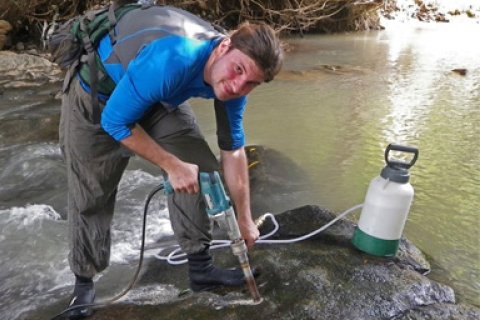Richest coral reefs appear millions of years older

Today, the coral reefs around Borneo contain the highest marine biodiversity in the world. According to new research from doctoral candidate Nathan Marshall of the University of Utrecht, and partnered researchers, the current high-biodiversity arrived millions of years earlier than what was once thought. Marshall conducted his research with scientists at Naturalis in Leiden and London's Natural History Museum. He will defend his PhD thesis on July 1, 2016, in the University Hall of Utrecht University.
The Coral Triangle, centered within the Indonesian Archipelago, contains the most biodiverse sea fauna in the world. For instance, more than ¾ of all coral species live in this biodiversity hotspot. However, there is relatively little research done in this area.
Keystone of global climate phenomena
The labyrinth of channels, straits and shallow seas around Indonesia is the only equatorial mixing zone of Earth’s oceans. This region is called the Indonesian Throughflow (ITF) and is a vital bottle neck between the Pacific and Indian Oceans. In the ITF, Heat and salt exchanges on a massive scale therefore plays an important role in many global climate phenomena such as the Asian Monsoons and El Niño. It is therefore further important to understand how this region operates.
The perfect location
Centered within the Coral Triangle is the island of Borneo, which is Indonesia’s largest island. Borneo has not always been an island; several times in the last 65 million years it has been connected to the surrounding islands and mainland Southeast Asia. Despite its importance within the ITF and birth of the current biodiversity hotspot, the island’s tectonic movement and geologic history is poorly understood. Hence, Borneo is a perfect location to study interplay of biodiversity, climate and tectonic activity.
Improved methods
“During my PhD, I worked to improve the dating and the methods for dating fossils,” says PhD student Nathan Marshall. “From the determination of strontium isotopes in fossils, to measuring magnetisms in rocks.”
The improved dating by Marshall and others has already led to a number of significant discoveries. Marshall: “We have confirmed much more accurately the extent of the Coral Triangle’s biodiversity was much earlier than classically thought. Previously, scientists hypothesized that the last ice ages, so up to two million years ago, were the cause of the explosion of biodiversity. But we have confirmed that this faunal-burst took place millions of years during the Middle Miocene or before. This was a period of high tectonic activity where the shallow seas were very muddy. It is unusual for modern coral reefs to be associated with muddy water, but in the Coral Triangle, corals and other fauna seem to have thrived in such environments."
Throughflow Project
Nathan Marshall conducted his research under the Throughflow Project, which was set up by, among others, the University of Utrecht, Naturalis Biodiversity Center in Leiden and the Natural History Museum in London.
Sustainability at Utrecht University
By combining its expertise in the field of Sustainability, Utrecht University develops integrated solutions for sustainability issues contributing to a better future for following generations. This theme connects Utrecht’s excellent sustainability research from the humanities, sciences and social sciences with a focus on water, energy and a healthy environment. Sustainability is one of the four research themes at Utrecht University.

